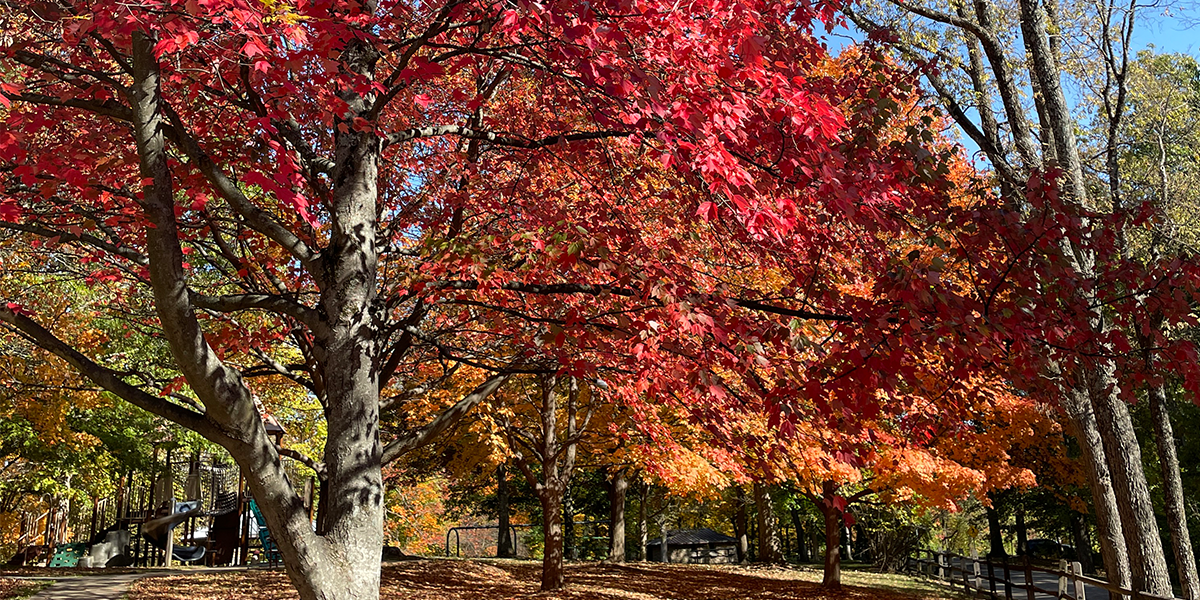Are invasive trees bad? When is it time to cut down a tree?
- Oct 24, 2023

Cincinnati Parks has been advocating to increase tree canopy coverage in the city for years through programs like ReLeaf and volunteer efforts. Our goal is to get every City of Cincinnati neighborhood to at least 40% canopy coverage. Whether we're planting trees in our parks or encouraging residents to plant them on their properties, we always emphasize the importance of planting native trees. Why? Because they support local wildlife and live in harmony with all other plants. Although we know the importance of native trees, we must also recognize that many of the old trees in our city aren't native. This brings up a commonly asked question, which is "what should we do about those non-native tree species?" We also often face the question, "when is it time to cut down a tree?" Our Urban Forestry Department staff are the experts in this field, and Garrett Dienno, Cincinnati Parks Land Manager, provided some insight into how to deal with these predicaments.
Are invasive trees bad and should they be removed?
Trees impact us in various ways and are valued for different reasons by different people. These include ecological and environmental benefits such as providing habitat or helping with mitigating urban heat islands. There are economic benefits such as increased real estate value, timber harvest, or production of agricultural products such as fruits or nuts. Then, there are the social benefits such as aesthetics, reducing stress, and the personal memories or historical importance a community may place on a tree.
Given the range of potential reasons why an individual or community may value a tree, it is entirely possible that an individual tree can have a high social benefit but little or potentially negative ecological/environmental value and in such cases, there really isn't a "right" answer.
A great example within Cincinnati Parks are the Weeping Cherry Trees (Prunus subhirtella var 'Higans') at Ault Park. We are finding increasing evidence that these trees actively seed out into the surrounding forests, which could lead to it becoming an invasive species in our area. However, these trees were originally planted as a memorial grove for those who lost their lives in World War I and have a high social and economic value to the community. Naturally, their outright removal would cause issues, and as an organization, we are left to find the best land management decision that is sensitive to both the ecological/environmental issues posed by these trees as well as their historical, social, and economic value by the community.
So, should you remove an invasive tree on your property? The short answer is it depends on your values. If you're trying to maximize the ecological and environmental benefits provided by your trees, then I would say yes. Removing invasive trees and replacing them with native trees that support more wildlife would be a great choice. However, if that Norway Maple in your front yard was planted by your grandfather and you grew up climbing on it and have fond memories spending the summer reading books in the tire swing that your mom made for you, then I don't think you need to feel guilty about leaving that tree alone. Instead, you could look to see if there are spaces on your property where you might be able to add new trees or landscaping that better support pollinators and other local wildlife.
When is it time to cut down a tree?
All trees eventually die and fail, even the mighty Redwoods of California or the 4,500-year-old Bald Cypress trees in the Carolina Black River swamps. However, the relative risk posed to people by trees is overall incredibly low. We are far more likely to be injured getting out of bed in the morning than we are by a tree (note, this may not apply to arborists or foresters as the tree care industry consistently ranks as one of the most dangerous in the country, but that's a separate discussion!).
If you are concerned about a tree on your property, there are certified arborists who can come out and professionally assess the risk a tree might pose. This assessment can help inform your decision regarding the management and care of your trees. Arborists who can offer this service will be Tree Risk Assessment Qualified by the International Society of Arboriculture. Within the Cincinnati Parks, all of our Lead Arborists, Urban Forestry Specialists, Urban Forestry Supervisor, Land Manager (that's me!), and Department of Natural Resources Division Manager have this credential.
As a general rule, if you're looking for someone to do tree work on your property, you should always ask them about their credentials and experience.
Trees are a vital resource for society, and especially for urban cities like Cincinnati. The benefits they provide are immense and we must continue to plant them for current and future generations. If you want to help the cause, plant a tree on your property or come out to volunteer at a park!
